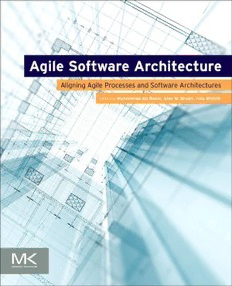
Agile Software Architecture Aligning Agile Processes and Software Architectures PDF
Preview Agile Software Architecture Aligning Agile Processes and Software Architectures
Agile Software Architecture This page intentionally left blank Agile Software Architecture Aligning Agile Processes and Software Architectures Edited by Muhammad Ali Babar Alan W. Brown Ivan Mistrik AMSTERDAM (cid:129) BOSTON (cid:129) HEIDELBERG (cid:129) LONDON NEW YORK (cid:129) OXFORD (cid:129) PARIS (cid:129) SAN DIEGO SAN FRANCISCO (cid:129) SINGAPORE (cid:129) SYDNEY (cid:129) TOKYO Morgan Kaufmann is an imprint of Elsevier AcquiringEditor:ToddGreen EditorialProjectManager:LindsayLawrence ProjectManager:PunithavathyGovindaradjane Designer:MariaIneˆsCruz MorganKaufmannisanimprintofElsevier 225WymanStreet,Waltham,MA02451,USA Copyright#2014ElsevierInc.Allrightsreserved Nopartofthispublicationmaybereproducedortransmittedinanyformorbyanymeans,electronic ormechanical,includingphotocopying,recording,oranyinformationstorageandretrievalsystem, withoutpermissioninwritingfromthepublisher.Detailsonhowtoseekpermission,furtherinformation aboutthePublisher’spermissionspoliciesandourarrangementswithorganizationssuchastheCopyright ClearanceCenterandtheCopyrightLicensingAgency,canbefoundatourwebsite:www.elsevier.com/ permissions. ThisbookandtheindividualcontributionscontainedinitareprotectedundercopyrightbythePublisher (otherthanasmaybenotedherein). Notices Knowledgeandbestpracticeinthisfieldareconstantlychanging.Asnewresearchandexperience broadenourunderstanding,changesinresearchmethodsorprofessionalpractices,maybecomenecessary. Practitionersandresearchersmustalwaysrelyontheirownexperienceandknowledgeinevaluating andusinganyinformationormethodsdescribedherein.Inusingsuchinformationormethodstheyshould bemindfuloftheirownsafetyandthesafetyofothers,includingpartiesforwhomtheyhaveaprofessional responsibility. Tothefullestextentofthelaw,neitherthePublishernortheauthors,contributors,oreditors,assume anyliabilityforanyinjuryand/ordamagetopersonsorpropertyasamatterofproductsliability, negligenceorotherwise,orfromanyuseoroperationofanymethods,products,instructions,orideas containedinthematerialherein. LibraryofCongressCataloging-in-PublicationData Agilesoftwarearchitecture:aligningagileprocessesandsoftwarearchitectures/editedbyMuhammad AliBabar,AlanW.Brown,IvanMistrik. pagescm Includesbibliographicalreferencesandindex. ISBN978-0-12-407772-0(pbk.) 1. Agilesoftwaredevelopment.2. Softwarearchitecture.I. AliBabar,Muhammad.II. Brown, AlanW.,1962-III. Mistrik,Ivan. QA76.76.D47A38442013 005.1’2–dc23 2013040761 BritishLibraryCataloguing-in-PublicationData AcataloguerecordforthisbookisavailablefromtheBritishLibrary ISBN:978-0-12-407772-0 ThisbookhasbeenmanufacturedusingPrintOnDemandtechnology.Eachcopyisproducedtoorderand islimitedtoblackink.Theonlineversionofthisbookwillshowcolorfigureswhereappropriate. ForinformationonallMKpublicationsvisitourwebsiteatwww.mkp.com Contents Acknowledgments...................................................................................................xv Aboutthe Editors..................................................................................................xvii List ofContributors................................................................................................xix Forewordby JohnGrundy......................................................................................xxi Forewordby Rick Kazman..................................................................................xxix Preface..................................................................................................................xxxi CHAPTER 1 Making Software Architecture and Agile Approaches Work Together: Foundations and Approaches.......... 1 1.1 Introduction..................................................................................1 1.2 Software Architecture..................................................................3 1.2.1 Software ArchitectureProcess andArchitecture Lifecycle...........................................................................4 1.2.2 ArchitecturallySignificant Requirements........................6 1.2.3 Software ArchitectureDesignMethods...........................8 1.2.4 DocumentingSoftware Architecture................................9 1.2.5 Software ArchitectureEvaluation..................................10 1.3 Agile Software Development and Architecture........................11 1.3.1 Scrum..............................................................................12 1.3.2 Extreme Programming...................................................13 1.4 Making Architectural and Agile Approaches Work.................14 Acknowledgments...............................................................................18 References............................................................................................19 PART 1 FUNDAMENTALS OF AGILE ARCHITECTING CHAPTER 2 The DCI Paradigm: Taking Object Orientation into the Architecture World.................................. 25 2.1 Introduction................................................................................26 2.1.1 Agile Apologia...............................................................27 2.1.2 Architectureand DCI.....................................................28 2.2 TheVision:What is Architecture?............................................28 2.2.1 Whydo we do Architecture?.........................................29 2.2.2 Into Software..................................................................29 2.2.3 WhySoftware Architecture?..........................................30 2.2.4 Architectureand the Agile Agenda...............................31 2.2.5 DCI asan IntegrativeView ofthe Architecture Metaphor.........................................................................32 v vi Contents 2.3 Form and Function inArchitectural History.............................32 2.3.1 HistoricMovements andIdeologies..............................34 2.3.2 Enter Postmodernism......................................................35 2.3.3 Architecture Finds an Object Foothold..........................35 2.3.4 Software Engineering andArchitecture Today.............36 2.3.5 Measures ofthe Vision..................................................36 2.4 What is Object Orientation? Achievingthe Vision..................37 2.4.1 The Kay Model...............................................................37 2.4.2 Mental System Models...................................................38 2.4.3 Model-View-Controller..................................................38 2.4.4 Patterns...........................................................................39 2.4.5 Use Cases........................................................................39 2.4.6 ManyViewsofObjectsandtheBoundaries ofMVC..............................................................................40 2.5 Shortcomings ofthe Models......................................................42 2.5.1 The Network Paradigm..................................................42 2.5.2 Model-View-Controller..................................................43 2.5.3 Patterns...........................................................................43 2.5.4 Use Cases........................................................................44 2.5.5 The Object Canon...........................................................45 2.6 DCI as aNew Paradigm............................................................49 2.6.1 ADCI Overview............................................................49 2.6.2 RelatingDCI tothe Original OOVision.......................52 2.6.3 DCI and the Agile Agenda.............................................53 2.7 DCI and Architecture.................................................................54 2.7.1 DCI and the Postmodern View......................................55 2.7.2 Patternsand DCI............................................................56 2.7.3 DCI and the NetworkComputation View.....................58 2.7.4 Firmitas,Utilitas, and Venustas.....................................58 2.8 Conclusion..................................................................................59 References............................................................................................60 Further Reading...................................................................................61 CHAPTER 3 Refactoring Software Architectures...................... 63 3.1 Introduction................................................................................63 3.2 Dealing with DesignFlaws........................................................64 3.3 Evolutionand Styles ofRefactoring—Code Refactoring.........65 3.4 Evolutionand Styles ofRefactoring—Refactoring to Patterns.......................................................................................66 3.5 The Motivationfor Software ArchitectureRefactoring............67 3.6 Architectural Smells...................................................................67 3.7 AReal-WorldExample.............................................................70 Contents vii 3.8 Quality Improvement.................................................................72 3.9 TheProcessof ContinuousArchitecture Improvement............73 3.10 Shallow and Deep Refactoring..................................................75 3.11 AdditionalExamples ofArchitecture RefactoringPatterns......75 3.11.1Breaking Dependency Cycles........................................75 3.11.2Splitting Subsystems......................................................75 3.12 Known ObstaclestoArchitectureRefactoring..........................78 3.13 ComparingRefactoring, Reengineering, and Rewriting...........79 3.14 Summary....................................................................................81 References............................................................................................82 CHAPTER 4 Driving Architectural Design and Preservation From a Persona Perspective in Agile Projects....... 83 4.1 Introduction................................................................................83 4.2 Personas inthe Design Space....................................................86 4.3 DiscoveringASRs......................................................................87 4.3.1 From Features to Architectural Concerns......................87 4.3.2 Embedding Architectural ConcernsIntoPersonas........90 4.4 Personas for Driving Architectural Design...............................93 4.4.1 Goal Analysis.................................................................94 4.4.2 Generatingand Evaluating Architectural Solutions......95 4.4.3 Examples........................................................................95 4.5 Personas andArchitectural Preservation.................................101 4.5.1 Trace By Subscription..................................................103 4.5.2 GeneratingPersona-centric Perspectives.....................103 4.5.3 Examples......................................................................103 4.6 ASPs inOther Project Domains..............................................105 4.6.1 MechatronicsTraceability............................................106 4.6.2 Online Trading..............................................................108 4.6.3 Bond, James Bond........................................................108 4.7 Conclusions..............................................................................109 Acknowledgments.............................................................................110 References..........................................................................................110 CHAPTER 5 Architecture Decisions: Who, How, and When?........................................................ 113 5.1 Introduction..............................................................................114 5.2 Research Methodology............................................................115 5.3 TheAgile ArchitectureAxesFramework...............................116 5.3.1 WhoMakesthe Architectural Decisions?...................117 5.3.2 What Artifacts AreUsedto Document the Decision?......................................................................118 viii Contents 5.3.3 What Isthe Feedback Loop ofAn Architectural Decision?......................................................................119 5.3.4 Summary ofthe Axes...................................................120 5.4 IndustrialCases........................................................................121 5.4.1 Case Alpha....................................................................121 5.4.2 Case Beta......................................................................122 5.4.3 Case Gamma.................................................................124 5.4.4 Case Delta.....................................................................125 5.4.5 Case Epsilon.................................................................126 5.4.6 Overview.......................................................................127 5.5 Analysis....................................................................................128 5.5.1 Mapping the Cases tothe Triple-A Framework..........128 5.5.2 IdentifiedProblems......................................................129 5.5.3 Summary.......................................................................130 5.6 Reflection.................................................................................130 5.6.1 Findings........................................................................131 5.6.2 Questions ofValidity...................................................131 5.7 Related andFutureWork.........................................................132 5.8 Conclusions..............................................................................133 Appendix AVisual Representation ofthe Case StudiesMapped on the Triple-A Framework...........................................................133 References..........................................................................................135 PART 2 MANAGING SOFTWARE ARCHITECTURE IN AGILE PROJECTS CHAPTER 6 Supporting Variability Through Agility to Achieve Adaptable Architectures......................... 139 6.1 Introduction..............................................................................139 6.2 Background..............................................................................141 6.2.1 Variability.....................................................................141 6.2.2 Agility...........................................................................142 6.3 Related Work...........................................................................143 6.4 Challenges when Combining Variabilityand Agility.............144 6.5 Arguments for Combining Variabilityand Agility.................145 6.6 Agile-Inspired Variability Handling........................................146 6.6.1 IndustrialContext: Dutch e-Government.....................148 6.6.2 Step 1:Conduct Initial Variability Analysis...............149 6.6.3 Step2:CreateInitialArchitectureVariabilityProfile...149 6.6.4 Step 3:Create Architecture..........................................150 Contents ix 6.6.5 Steps 4aand 4b:Evaluate Architecture.......................151 6.6.6 Step 5:Implement Initial Architecture........................154 6.6.7 Step 6:ElicitNew VariabilityRequirements..............154 6.6.8 Step 7:ReviseArchitectureVariability Profile...........154 6.6.9 Step 8:Refactor Architecture.......................................155 6.7 Summary and Conclusions......................................................155 Acknowledgments.............................................................................157 References..........................................................................................157 CHAPTER 7 Continuous Software Architecture Analysis............................................................ 161 7.1 Introduction..............................................................................161 7.2 Software ArchitectureAnalysis...............................................162 7.3 Approaches toSoftware ArchitectureAnalysis......................164 7.3.1 ArchitectureReviews...................................................164 7.3.2 Scenario-Based Evaluation Methods...........................165 7.3.3 ArchitectureDescription Languages............................165 7.3.4 DependencyAnalysis Approaches and Architecture Metrics..........................................................................166 7.3.5 ArchitecturePrototyping..............................................166 7.3.6 Ad Hoc Analysis...........................................................167 7.4 Continuous Software Architecture Analysis...........................167 7.4.1 CSAA and DifferentKinds ofArchitecture Analysis........................................................................168 7.4.2 ApproachesforContinuousQualityControl(CQC).....169 7.4.3 Characteristics of CQC Approaches............................169 7.4.4 CSAA Process..............................................................170 7.5 CSAA inExisting Approaches................................................171 7.6 CSAA and Analysis Goals.......................................................173 7.7 ExperiencesWith An Approach toCSAA..............................176 7.7.1 Validation.....................................................................179 7.8 Findings and ResearchChallenges..........................................182 7.9 Conclusion................................................................................183 References..........................................................................................184 CHAPTER 8 Lightweight Architecture Knowledge Management for Agile Software Development ...... 189 8.1 Introduction..............................................................................189 8.2 Challengesof Agile Architecture Documentation..................191 8.3 SupportingTechniques for AKM in Agile Software Development............................................................................193
